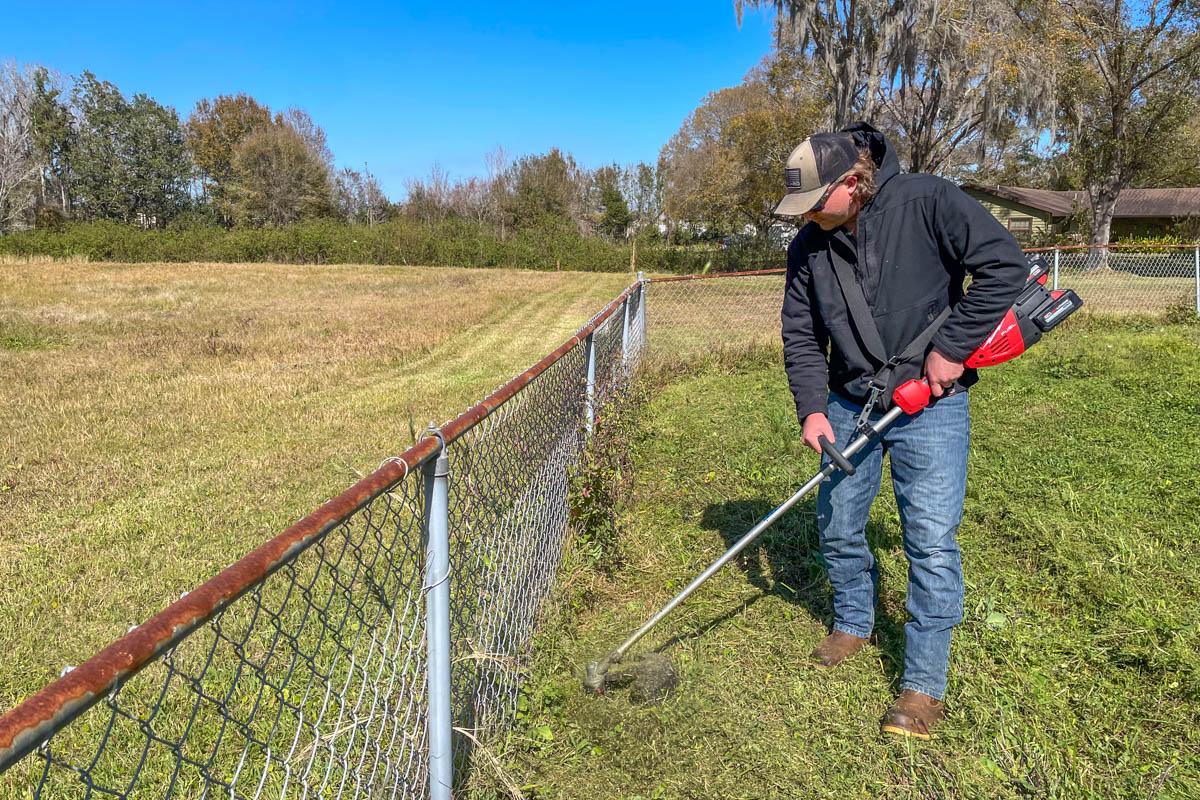Whether you call it a weed eater, weed wacker, weed trimmer, or something else, string trimmers have the same fundamental concept—spin trimmer line fast enough for the tips to cut grass. If you ask a random sampling of five people, they’ll likely tell you five different models they’d choose as the best string trimmer. Pro Tool Reviews tested dozens of gas and battery-powered string trimmers to discern the top performers. Based on hands-on testing and more than fifteen years of reviewing, I’ve selected my top favorites for professionals and homeowners.
Our Top-Rated String Trimmer Recommendations
For Professionals
- Echo X-Series String Trimmer SRM-2620T
↓ Jump to this String Trimmer - Stihl Professional String Trimmer FS 91 R
↓ Jump to this String Trimmer - Stihl FSA 135 R Battery-Powered String Trimmer
↓ Jump to this String Trimmer - Husqvarna 520iLX Battery-Powered String Trimmer
↓ Jump to this String Trimmer - Milwaukee M18 Fuel Dual Battery String Trimmer 3006-22
↓ Jump to this String Trimmer
For Homeowners
- EGO PowerLoad String Trimmer with Line IQ ST1623T
↓ Jump to this String Trimmer - Ryobi 40V HP Brushless Carbon Fiber String Trimmer RY402110
↓ Jump to this String Trimmer - Greenworks 60V Carbon Fiber String Trimmer 2136502
↓ Jump to this String Trimmer
Best Gas String Trimmers for Professionals
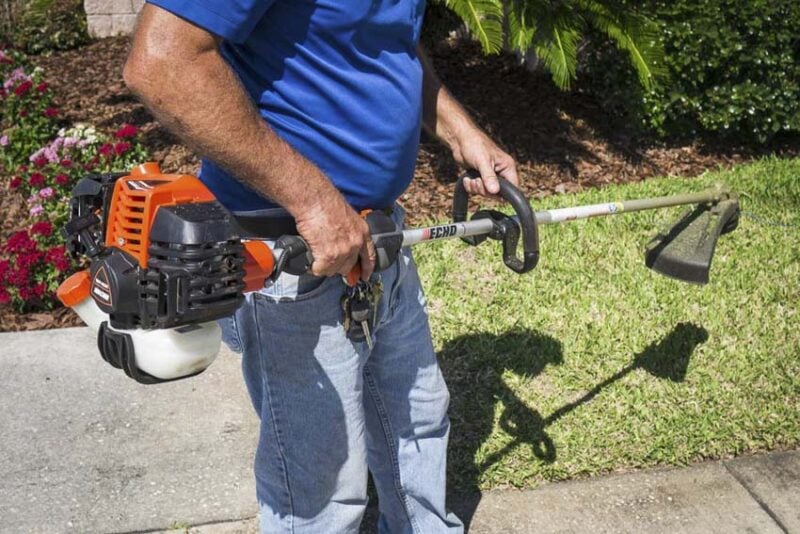
Echo X-Series SRM-2620T
- Engine: 25.4 cc
- Cutting Swath: 17 inches
- Line Size: 0.095 – 0.105 inches
- Top Speed: 5500 RPM
- Dry Weight: 12.5 pounds
Why I Love It
There’s a ton of debate about which is the best gas string trimmer overall, and Echo consistently shows up in it with their X-Series SRM-2620 lineup. It’s not the most powerful in Echo’s suite of Pro-focused string trimmers, but it does balance performance and weight. Furthermore, it’s a reliable option.
My top recommendation is the “T” model, which has 2:1 high-torque gearing. While the top speed is lower than the standard gearing, it gets the job done on regular cuts and keeps the speed up better when you’re dealing with overgrowth. If you’re only going to have one string trimmer, the SRM-2620T can do it all.
Reasons to Buy
- 2:1 gear ratio for higher torque
- 2-stage air filtration
- Generous 20.6-ounce fuel tank
- Speed Feed 400 head included
- Narrow guard offers excellent line of sight
- Also available with standard gearing (SRM-2620) and in a bike handle configuration (SRM-2620U)
Consider Another Model If You…
- Need more engine power
- Prefer a wide guard
- Prefer lighter weight over higher power
- Are in a noise-restricted area
- Prefer the lower noise and convenience of battery power
Who Should Buy It?
With its reliability, performance, and generous fuel capacity, this is a string trimmer that professional crews should consider for every application—mow and blow, right-of-way maintenance, agriculture, campus maintenance, and more. It’s also an excellent option for large property owners and comes with a 5-year residential (2-year commercial) warranty.

Stihl FS 91 R String Trimmer
- Engine: 28.4 cc
- Cutting Swath: 16.5 inches
- Line Size: 0.095 – 0.105 inches
- Top Speed: 7150 RPM
- Dry Weight: 12.1 pounds
Why I Love It
Similar to Echo, Stihl’s FS 91 R isn’t the most powerful string trimmer in the lineup, but its balance of performance, weight, and price makes it a top-rated model for many people. Its top speed makes maintenance cutting a breeze, and it can handle overgrowth confidently. While Echo does boast better torque, Stihl’s engine is a little stronger, the fuel capacity is a little higher, and its dry weight is a little lower (though the additional fuel capacity evens the working weight out).
Of course, Stihl’s extensive dealer and service network is a major plus of owning its products. When you need regular maintenance or your trimmer needs a repair, you can get it back in the game quickly.
Reasons to Buy
- High line speed
- Generous 24-ounce fuel tank
- Reliable performance
- Wide service network to handle maintenance and repairs
- Made in the USA using global components
- Also available in a bike handle configuration (FS 91)
Consider Another Model If You…
- Need more engine power
- Prefer a narrow guard
- Prefer lighter weight over higher power
- Are in a noise-restricted area
- Prefer the lower noise and convenience of battery power
Who Should Buy It?
This is primarily for professional crews needing high-speed cutting to move through jobs quickly. While it’s capable of working through overgrowth, you might want to have a high-torque model on hand if it’s a significant part of your day.
Top-Rated Battery-Powered String Trimmers for Professionals
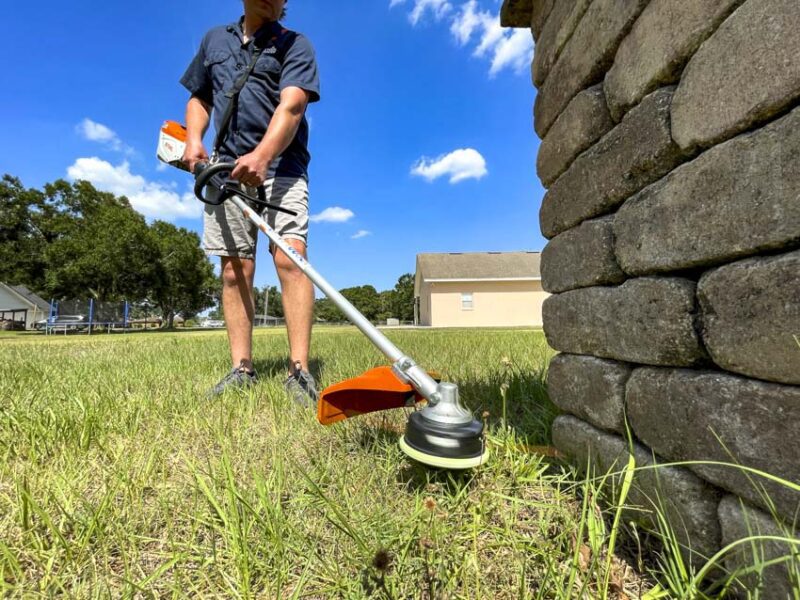
Stihl FSA 135 R String Trimmer
- Motor: 36V Brushless
- Cutting Swath: 16.5 inches
- Line Size: 0.095 – 0.105 inches
- Top Speed: 5900 RPM
- Bare Weight: 11.4 lbs. (15.5 lbs. w/AP 500)
Why I Love It
Stihl’s FSA 135 R is the battery-powered version of the FS 91 R, and it’s the best all-around battery-powered model for professionals. Square in the middle in weight and performance, it has the power you need for most trimming duties while keeping the weight reasonable and build quality high.
Reasons to Buy
- Excellent all-around trimming performance
- Pro-grade build quality
- No fuel to mix
- No emissions
- Little noise compared to gas
- Little maintenance to worry about
- Can save money compared to gas models over the life of the trimmer
- Also available in a bike handle version (FSA 135)
Consider Another Model If You…
- Need the highest power or high torque gearing
- Don’t want the front-end cost of battery equipment
- Run your trimmers without a guard and line cutter
Who Should Buy It?
Pros looking for a battery-powered all-day everyday workhorse should consider the FSA 135 R. Matching up with Stihl’s popular FS 91 R on the gas side, there’s no compromise in performance or build quality.
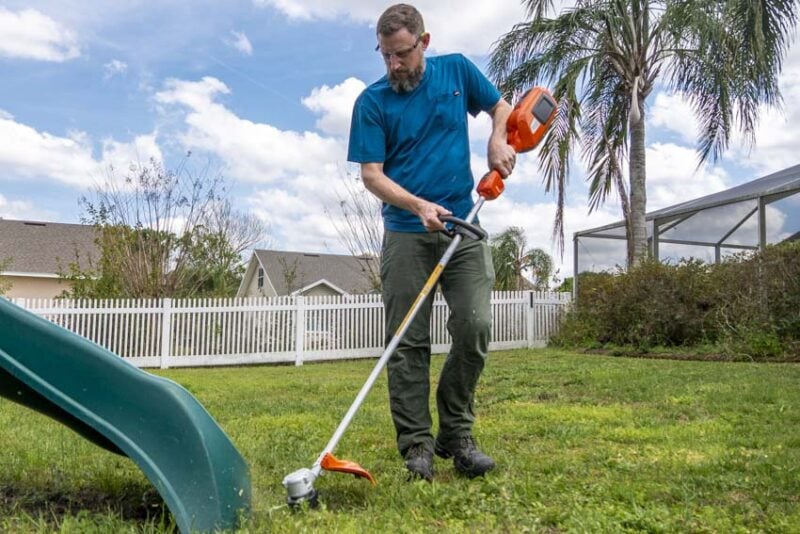
Husqvarna 520iLX String Trimmer
- Motor: 36V Brushless
- Cutting Swath: 16 inches
- Line Size: 0.080 – 0.095 inches
- Top Speed: 5500 RPM
- Bare Weight: 6.6 lbs. (9.5 lbs. w/BLi200)
Why I Love It
Even though it’s not the highest-performing model in Husqvarna’s battery-powered lineup, the 520iLX stays on my list again this year because of its low weight and low vibration. It’s a flat-out comfortable string trimmer to use. Combined with low noise and battery-powered convenience, it’s a joy to operate.
Reasons to Buy
- Lightweight
- Super-low vibration
- Reverse mode
- Eco mode for light cutting conditions
- No fuel to mix
- No emissions
- Little noise compared to gas
- Little maintenance to worry about
- Can save money compared to gas models over the life of the trimmer
Consider Another Model If You…
- Need more power or high torque gearing
- Don’t want the front-end cost of battery equipment
- Want a larger cutting swath
- Run your trimmers without a guard and line cutter
- Run 0.105-inch line
- Prefer a fast-load trimmer head
- Frequently work in overgrown areas
Who Should Buy It?
This model is best suited for professional use on regular maintenance cuts. Thanks to high-capacity battery backpacks, it’s good for large properties and campuses in addition to smaller lawns. Its power level isn’t as high as others, though, so it’s not a good fit if you’re frequently reclaiming overgrown areas.
Built for professional and large property use, Husqvarna’s 520iLX is a cordless battery-powered string trimmer that should be on your radar. Its performance is right on for hitting lawn grasses and we like the reverse direction button to release tangled grass.
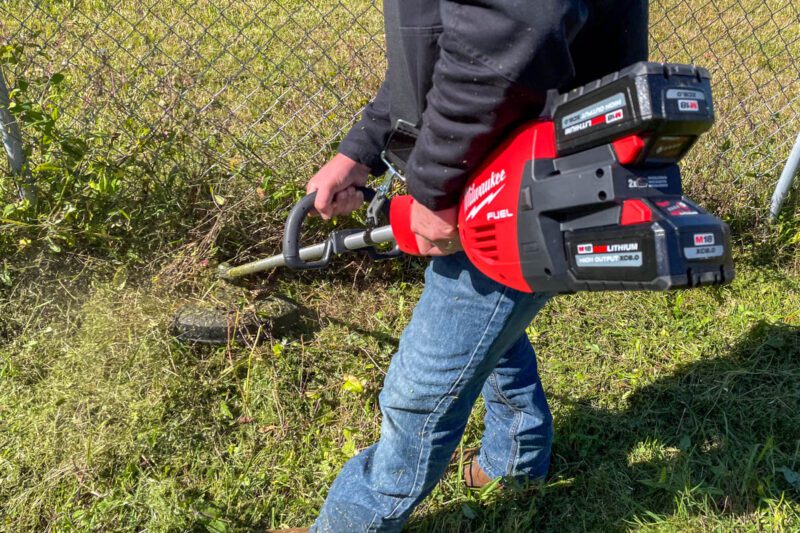
Milwaukee Dual Battery String Trimmer
- Motor: 18V Brushless
- Cutting Swath: 17 inches
- Line Size: 0.080 – 0.105 inches
- Top Speed: 6200 RPM
- Bare Weight: 11.8 lbs. (16.9 lbs. w/8Ah packs)
Why I Love It
Milwaukee took a huge step forward with its string trimmer performance with the launch of the M18 Fuel 3006. Its low-speed mode beautifully handles regular maintenance trimming, and its high speed makes quick work of overgrowth. With the ability to run line up to 0.105 inches, it’s a high-performance beast of a trimmer.
Reasons to Buy
- High-end cutting performance
- Larger cutting swath than most battery-powered models
- Includes a fast-loading trimmer head
- Includes a shoulder strap
- No fuel to mix
- No emissions
- Little noise compared to gas
- Little maintenance to worry about
- Can save money compared to gas models over the life of the trimmer
Consider Another Model If You…
- Prioritize lightweight over high-performance
- Don’t want the front-end cost of battery equipment
- Run your trimmers without a guard and line cutter
Who Should Buy It?
Milwaukee focuses on professional users, and the 3006 is no exception. While you do need to consider whether the weight is an issue for you and your crew, the M18 Fuel Dual Battery String Trimmer can handle anything you’d use a gas model for.
Best Battery-Powered String Trimmers for Homeowners
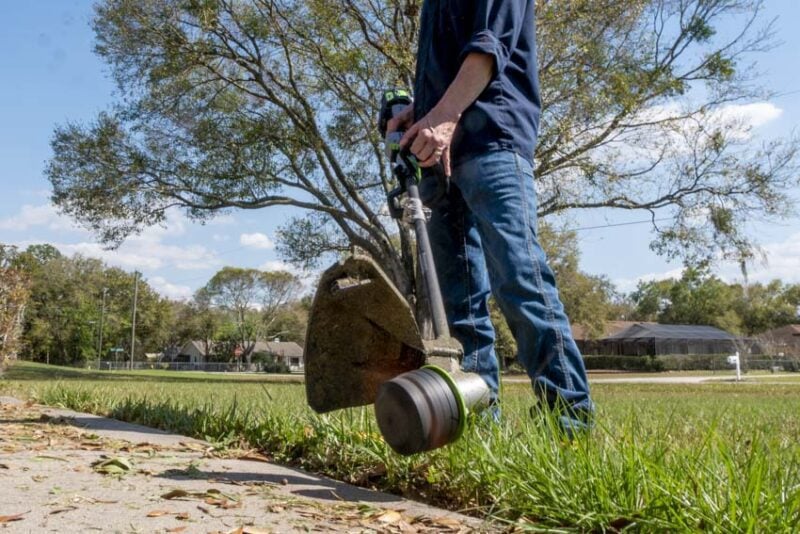
EGO PowerLoad with Line IQ ST1623T
- Motor: 56V Brushless
- Cutting Swath: 16 inches
- Line Size: 0.095 inches
- Top Speed: 5500 RPM
- Bare Weight: 7.7 lbs. (12.5 lbs w/5Ah battery)
Why I Love It
This is the best string trimmer homeowners can currently buy. The Line IQ and Powerload technologies make it incredibly convenient to use while the performance is excellent and vibration control is outstanding.
Reasons to Buy
- Excellent cutting performance
- Outstanding vibration control
- Automatic line feeding
- Super-easy automatic line loading
- Carbon fiber shaft
- No fuel to mix
- No emissions
- Little noise compared to gas
- Little maintenance to worry about
Consider Another Model If You…
- Want the highest possible performance
- Prefer lighter weight over high performance
- Want to run line other than 0.095-inch
- Prefer a cutting swath other than 16 inches
- Are working with an entry to mid-level budget
- Want an attachment-capable system
Who Should Buy It?
EGO designed this string trimmer for homeowners who want the best in technology combined with high performance.
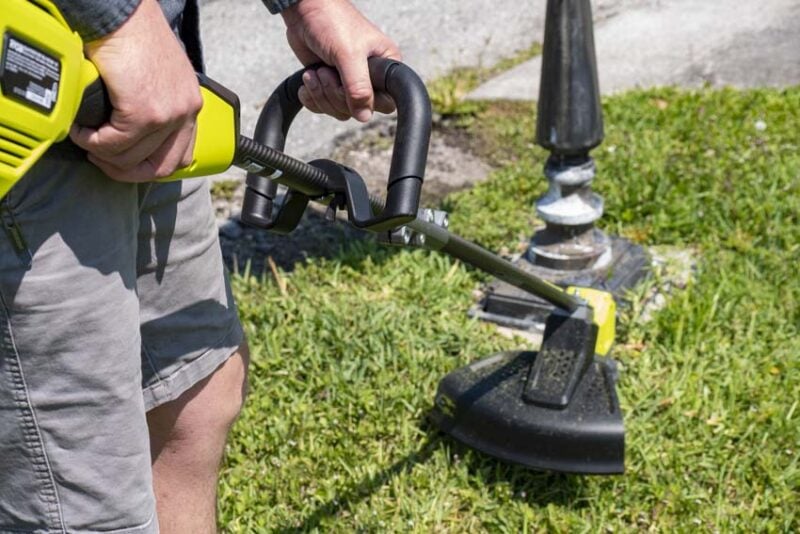
Ryobi 40V HP Carbon Fiber RY402110
- Motor: 40V Brushless
- Cutting Swath: 17 inches
- Line Size: 0.080 – 0.105 inches
- Top Speed: Not rated
- Bare Weight: 8.8 lbs. (12.9 lbs. w/6Ah battery)
Why I Love It
This Ryobi model delivers the highest power I’ve experienced in a residential battery-powered string trimmer. It’s also much better at vibration control than older models I’ve tested, and the weight is very reasonable, considering how much power the brushless motor produces.
Reasons to Buy
- Top-tier cutting performance
- Larger cutting swath than most battery-powered models
- Low vibration
- Includes a fast-loading trimmer head
- Carbon fiber shaft
- No fuel to mix
- No emissions
- Little noise compared to gas
- Little maintenance to worry about
- Can save money compared to gas models over the life of the trimmer
Consider Another Model If You…
- Want the lightest weight
- Prefer to stay on Ryobi’s 18V One+ battery system
- Are working with an entry to mid-level budget
- Want an attachment-capable system
Who Should Buy It?
This premium string trimmer is for homeowners who want the power of the strongest gas string trimmers with the convenience of a battery power source. If you’re fighting overgrowth often, you’ll love it.
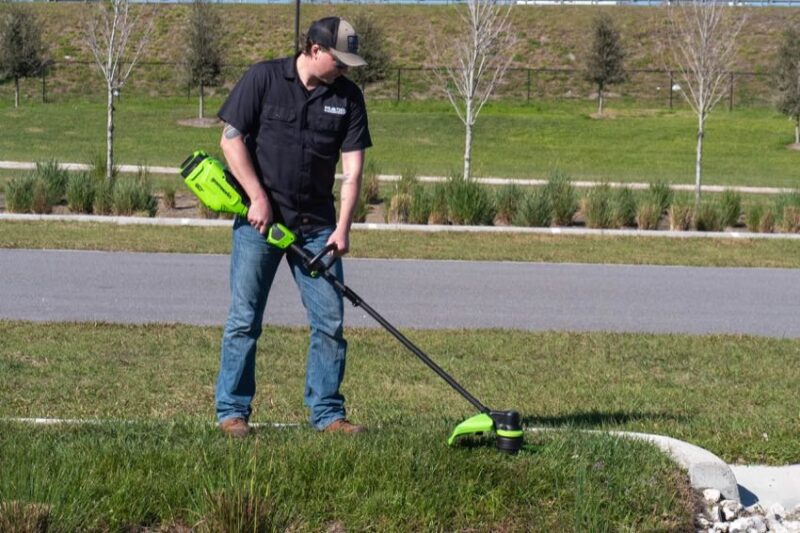
Greenworks 60V Carbon Fiber 2136502
- Motor: 60V Brushless
- Cutting Swath: 16 inches
- Line Size: 0.095 inches
- Top Speed: Not rated
- Weight: 9.9 lbs. w/2.5Ah battery
Why We Love It
Greenworks makes the list thanks to its lightweight performance. Coming in just under 10 pounds and keeping the vibration low, it’s easy to use. Performance doesn’t suffer, though, and this model easily replaces most residential gas models.
Reasons to Buy
- Excellent cutting performance
- Low vibration
- Includes a fast-loading trimmer head
- Carbon fiber shaft
- No fuel to mix
- No emissions
- Little noise compared to gas
- Little maintenance to worry about
- Can save money compared to gas models over the life of the trimmer
Consider Another Model If You…
- Are willing to give up performance for even lower weight
- Want the highest possible performance
- Are looking for more than a 16-inch cutting swath
- Are working with an entry to mid-level budget
- Want an attachment-capable system
Who Should Buy It?
Homeowners who want high performance at the lowest weight will love this model. While you can find battery-powered string trimmers with a lower overall weight, it’ll be tough to find any that can compete with Greenworks in cutting performance without bloating the weight to do it.
Also In This Article
- Why You Can Trust Pro Tool Reviews
- The String Trimmer Line Pros Recommend
- More Trimmers from Brands We Recommend
- String Trimmer Buying Guide
- Related Content
Why You Can Trust Pro Tool Reviews on String Trimmers
Having been around since 2008, writing in-depth tools reviews in the construction, automotive, and lawn care industries, Pro Tool Reviews has its finger on the pulse of the industry. Our reviewers work in the trades and have the skills and experience to help you understand whether a tool will perform well on the jobsite.
Each year, we bring in and review more than 250 individual products. Our team will put our hands on hundreds of additional tools at media events and trade shows throughout the year. We also consult with the innovators who developed the technology and who design power tools and accessories to gain a broader grasp of where these products fit and how they work.
I don’t recommend anything I wouldn’t use. Thanks to the editorial, scientific, and real-world professional experience we collect each time we pick up and test a tool, the end result is information you can trust.
The String Trimmer Line We and Our Pros Recommend
Echo Black Diamond String Trimmer Line
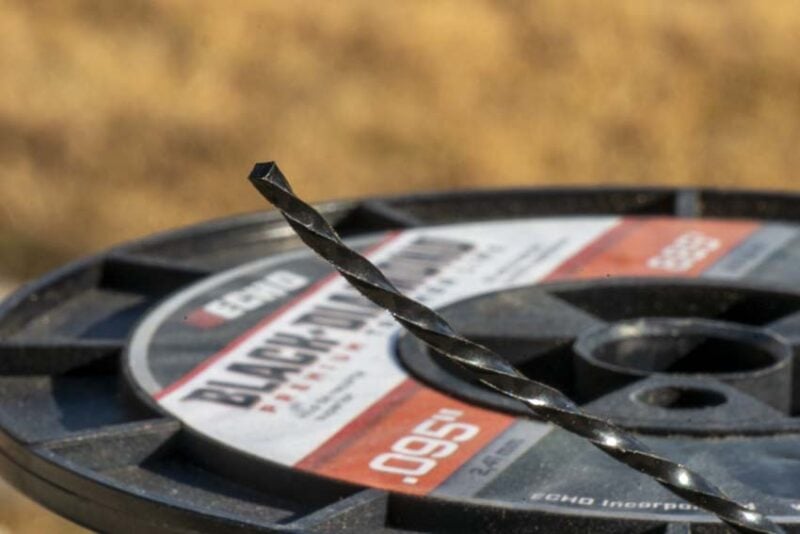
There’s no question I’m going to start an argument in this section (even within our own office), but the best string trimmer line is Echo’s Black Diamond line. It’s denser than many of the basic lines out there, combined with a sharp-pointed square twist to make it a more effective cutter for its size. Available in 0.095-inch and 0.105-inch sizes, it’s great for almost any trimmer and a fantastic choice for battery-powered options.
The only caution I give is when using automatic loading systems. These can have difficulty with the edges of this line. For those, I recommend using a smooth or rounded trimmer line.
Best String Trimmer Brand

If the last section sparked an argument, this one is going to start an all-out brawl. When it comes to covering the entire scope of string trimmers, Echo, Husqvarna, and Stihl are all consistently part of the conversation, with other brands such as Makita and Redmax also showing up. Toss in all-battery brands such as Milwaukee and Greenworks Commercial, and the landscape can be confusing.
In my opinion, Stihl and Husqvarna are the best overall string trimmer brands. They have a wide range that covers homeowners through professionals, gas and battery, and lawn cutting through forestry brush cutting better than anyone else. While Stihl sets the standard for servicing dealer networks, Husqvarna does a fine job of showing up close to home as well.
More String Trimmers from Brands We Recommend
For Pros: Greenworks Commercial Optimus 82V String Trimmer ST161
Rated at 1.6kW, this string trimmer isn’t as strong as Greenworks Commercial’s 2.0kW bike handle model, but it’s the combination of lighter weight and 30cc+ performance that makes it the one I want to reach for.
Key Figures
- Motor: 82V Brushless
- Cutting Swath: 17 inches
- Line Size: 0.095 inches
- Top Speed: 5500 RPM
- Weight: 15.5 pounds with a 4.0Ah battery
- Warranty: 2 years
Price: $649.99
For Pros: Echo 56V String Trimmer DSRM-2600
Echo’s Pro-focused battery-powered string trimmer (also available in a bikehandle version) is a lightweight option with mid-range performance. As part of the expanding eForce X-Series lineup, it’s a good fit for professionals primarily focused on maintenance trimming.
Key Figures
- Motor: 56V Brushless
- Cutting Swath: 17 inches
- Line Size: 0.080 – 0.095 inches
- Top Speed: 5700 RPM
- Weight: 10.0 pounds with a 2.5Ah battery
- Warranty: 5 years consumer, 2 years commercial
Price: $599.99 kit; $479.99 bare
For Pros: Makita 40V max XGT High-Torque String Trimmer
Geared for higher torque and capable of turning 18 inches of trimmer line, Makita’s GRU07 stands out in the cordless category, and that’s saying something considering the quality in the brand’s lineup. Perhaps even more impressive than the 35cc+ performance is that the working weight is under 14 pounds.
Key Figures
- Motor: 40V Brushless
- Cutting Swath: 18 inches
- Line Size: 0.105 inches
- Top Speed: 5700 RPM
- Weight: 13.5 pounds with a 5.0Ah battery
- Warranty: 2 years
Price: TBA
For Homeowners: Masterforce FlexPower 20V String Trimmer 4812.17
Homeowners with smaller lawns and a desire for a lightweight string trimmer will love the convenience of Masterforce’s 12-inch string trimmer. While it doesn’t include a fast-load trimmer head, it makes up for it with its low cost, excellent runtime, incredibly low weight, and compatibility with Masterforce’s entire line of 20V power tools.
Key Figures
- Motor: 20V Brushless
- Cutting Swath: 12 inches
- Line Size: 0.080 inches
- Top Speed: 7000 RPM
- Weight: 7.3 pounds with a 4.0Ah battery
- Warranty: 3 years
Price: $139.99 with a 4.0Ah battery and charger
For Homeowners: Ridgid 18V Brushless String Trimmer R01201
Ridgid fans now have lawn care equipment options that keep them on the popular 18V battery system. The string trimmer is a good fit for small to medium size lawns with its 14-inch cutting swath and it’s a lightweight option that has a working weight under 10 pounds. Thanks to the brushless motor’s ability to confidently use 0.095-inch line, it’s capable of both maintenance trimming and clearing smaller areas of overgrowth with ease.
Key Figures
- Motor: 18V Brushless
- Cutting Swath: 14 inches
- Line Size: 0.095 inches
- Top Speed: 6200 RPM
- Weight: 9.5 pounds with a 4.0Ah battery
- Warranty: 3 years and Lifetime Service Agreement with registration
For Homeowners: Skil PWRCore 40 String Trimmer with Smart Load LT4832C-11
Skil puts together a string trimmer kit that’s an excellent value. Stepping up to the more powerful PowerCore 40 battery system, this 15-inch string trimmer is a good fit for any size home and is another excellent lightweight option. It stands out with its Smart Load system that makes line loading as easy as running the line through the head to the middle and then spinning the handle to wind it in.
Key Figures
- Motor: 40V Brushless
- Cutting Swath: 15 inches
- Line Size: 0.080 inches
- Top Speed: 5800 RPM
- Weight: 9.25 pounds with a 2.5Ah battery
- Warranty: 5 years
String Trimmer Buying Guide – What We Look For
Gas vs Battery vs Electric String Trimmers
Choosing your string trimmer power source has a lot to do with balancing performance, convenience, and price.
Gas offers the most power and when you run out of fuel, a fill-up only takes a few minutes. On the other hand, they’re loud, require maintenance, need an oil and gas mix, and produce emissions.
Battery-powered string trimmers have lower noise, no emissions, and very little maintenance. Plus, today’s performance can match a 30cc engine with roughly the same runtime as a tank of gas. However, cordless string trimmers can be more expensive, and charging a battery can sometimes take several hours.
Electric string trimmers offer the benefits of battery-powered ones, including the bonus of costing less and having near-infinite runtime. However, they typically don’t reach as high on the power scales, and you’re stuck dragging an extension cord all over your lawn.
String Trimmer Line Size
Most string trimmers are rated for somewhere between 0.080 and 0.105-inch line with fringe options below and above that range (one string trimmer even uses zip ties, but we don’t recommend it).
Generally speaking, a smaller-diameter line doesn’t do as much damage to objects it hits, such as the paint on your exterior walls, wood on your pergola, or irrigation pipes. It also gets the most runtime out of battery-powered string trimmers. As you go up in diameter, the line becomes more destructive and less energy efficient while holding up better in tough conditions.
For smaller lawns, 0.080-inch line is great for keeping your grass under control, has excellent runtime for battery-powered string trimmers, and lets you put more line on the head compared to larger diameters. This is the minimum line size we recommend in most cases.
The 0.095-inch line is a great all-around combination for quick cutting, moderate risk of collateral damage, and solid runtime for cordless trimmers. This is as thick as we recommend going for most cordless string trimmers, though some Pro models are fine moving up a step.
For professional crews, farm and ranch, and other large properties, 0.105-inch line is the way to go. It quickly clears overgrowth and grasses with thicker stalks while holding up to a lot of abuse. It takes more energy to spin the extra mass, though, and you likely need a 30cc+ engine to make the most effective use of it. If you’re considering battery-powered options, we only recommend 0.105-inch line for high-end professional models specifically designed to handle it.
Cutting Swath
Cutting swath is the diameter your line covers. For smaller lawns, 13–14 inches is fine, especially when you’re using a walk-behind mower that can get closer to landscape edges. 15–16 inches is a good all-around diameter, while professional crews and large property owners get the most out of 17 inches or more.
Weight
String trimmer weight is a big consideration. The more weight is out on the end, the more your back has to work to help you work with it. Shoulder straps help tremendously, especially for the largest gas units; some cordless models also come with one.
In most cases, pick the lightest string trimmer. It should have the performance for your toughest jobs and a build quality that will last you many years.
Vibration
Vibration came into center focus with high-performance cordless string trimmers. All gas engines have at least some vibration, and most people don’t think much of it. That’s still the case for gas, but cordless and electric string trimmers vary widely in how much vibration they create. In many cases, shifting the motor to the head helps reduce the vibration of a drive shaft, even though it moves some of the weight away from your arms.
Features
For the most part, there aren’t a ton of extra features to look for on gas and AC electric string trimmers. However, brushless battery-powered models can have a few that can swing your purchase decision one way or the other. Here are some to keep an eye on:
- Attachment capability (all power types)
- Multiple speeds (including automatic modes)
- Reverse rotation to untangle tall grass
- Faster throttle up
- Compatibility with other lawn care equipment and power tools
Value
We’re big on value—getting the most bang for our buck is always high on our list. It’s not just about the cheapest string trimmer. It’s about meeting your top priorities and coming in under budget.

